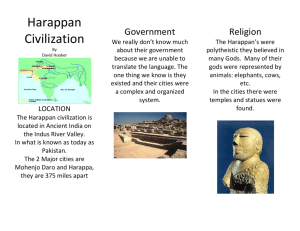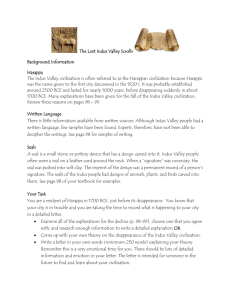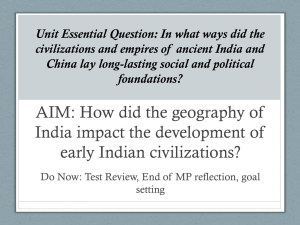Lesson 01 – The Indus Valley Civilization
advertisement
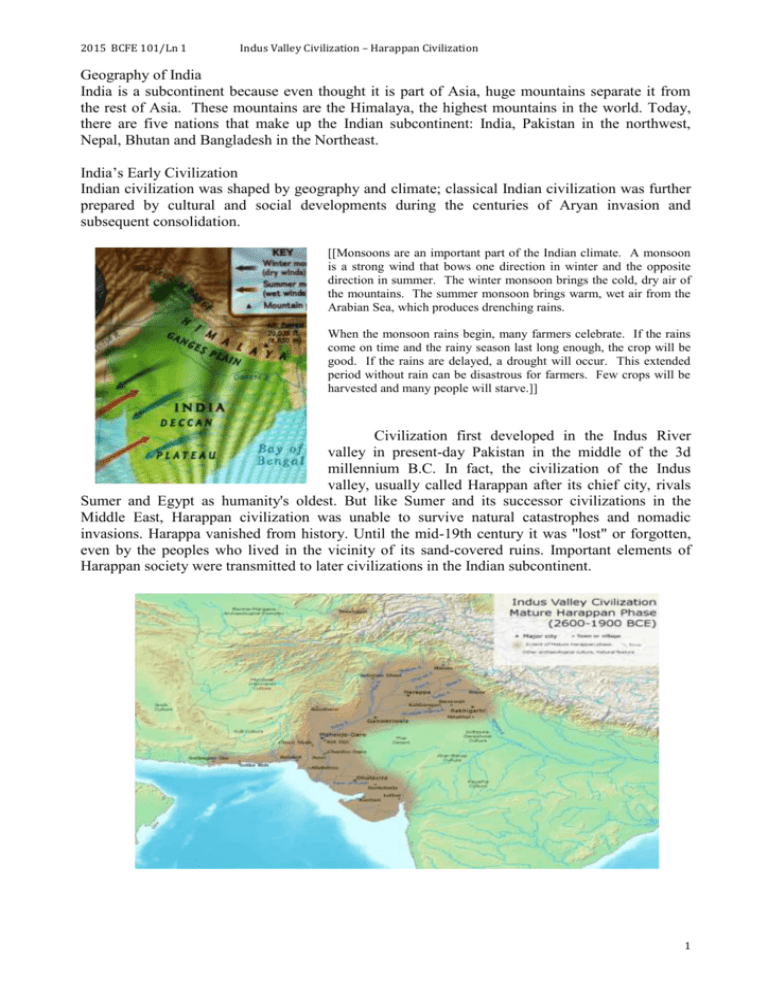
2015 BCFE 101/Ln 1 Indus Valley Civilization – Harappan Civilization Geography of India India is a subcontinent because even thought it is part of Asia, huge mountains separate it from the rest of Asia. These mountains are the Himalaya, the highest mountains in the world. Today, there are five nations that make up the Indian subcontinent: India, Pakistan in the northwest, Nepal, Bhutan and Bangladesh in the Northeast. India’s Early Civilization Indian civilization was shaped by geography and climate; classical Indian civilization was further prepared by cultural and social developments during the centuries of Aryan invasion and subsequent consolidation. [[Monsoons are an important part of the Indian climate. A monsoon is a strong wind that bows one direction in winter and the opposite direction in summer. The winter monsoon brings the cold, dry air of the mountains. The summer monsoon brings warm, wet air from the Arabian Sea, which produces drenching rains. When the monsoon rains begin, many farmers celebrate. If the rains come on time and the rainy season last long enough, the crop will be good. If the rains are delayed, a drought will occur. This extended period without rain can be disastrous for farmers. Few crops will be harvested and many people will starve.]] Civilization first developed in the Indus River valley in present-day Pakistan in the middle of the 3d millennium B.C. In fact, the civilization of the Indus valley, usually called Harappan after its chief city, rivals Sumer and Egypt as humanity's oldest. But like Sumer and its successor civilizations in the Middle East, Harappan civilization was unable to survive natural catastrophes and nomadic invasions. Harappa vanished from history. Until the mid-19th century it was "lost" or forgotten, even by the peoples who lived in the vicinity of its sand-covered ruins. Important elements of Harappan society were transmitted to later civilizations in the Indian subcontinent. 1 2015 BCFE 101/Ln 1 Indus Valley Civilization – Harappan Civilization The Indus Valley And The Genesis Of South Asian Civilization Great torrents of water from the world's highest mountain range, the Himalayas, carved out the vast Indus River system that was to nurture the first civilization in the Indian subcontinent. As the rapidly running mountain streams reached the plains of the Indus valley, they branched out into seven great rivers, of which five remain today. These rivers in turn converge midway down the valley to form the Indus River, which runs for hundreds of miles to the southwest and empties into the Arabian Sea. The streams flowed from high in the Himalayas are fed by monsoon rains. Rain clouds are carried from the seas surrounding the Indian subcontinent by monsoons - seasonal winds - across the lowlands to the mountains where, cooled and trapped, they release their lifegiving waters. These "summer" or wet monsoons, which blow toward central Asia from the sea, are also a critical source of moisture for the plains and valleys they cross before they reach the mountain barriers. The streams from the mountains also carry prodigious amounts of rich soil to these plains, constantly enlarging them and giving them the potential for extensive cultivation and dense human habitation. The Indus is only one of many river systems in the Indian subcontinent formed by melting snow and monsoon rains, but it was the first to nurture a civilization. The lower Indus plains were a very different place in the 3d millennium B.C. than they are today. Most of the region is now arid and desolate, crisscrossed by dried-up riverbeds and virtually devoid of forests. In Harappan times, it was green and heavily forested. Game animals and pasturage for domesticated animals were plentiful. Long before the first settlements associated with the Harappan complex appeared, the plains were dotted with the settlements of sedentary agriculturists. By at least 3000 B.C., these pre-Harappan peoples cultivated wheat and barley, and had developed sophistacated agricultural implements and cropping techniques. The pre-Harappan peoples knew how to make bronze weapons, tools, and mirrors, and they had mastered the art of pottery making. Recurring motifs, such as bulls and long-horned cattle on elaborately decorated bowls and storage urns, suggest links to early agricultural communities in the Middle East, while fish designs indicate a preoccupation with what was probably a major source of food. The long-horned bull was a central image in the Harappan culture and remains important in Indian iconography, the art of pictorial representation. PreHarappan peoples in the Indus valley also carved large numbers of small figurines of women. These statuettes differ from those found in many other early cultures in the detailed attention given to hairstyles and jewelry. Early village sites also contained tiny carts with clay wheels that may be the earliest children's toys yet discovered. The Discovery And Mystery Of Harappa Excavated ruins of Mohenjo-daro, with the Great Bath in the front. In the late 1850s, the British were directing the building of railway lines through the Indus valley. In need of bricks for the railway bed, the engineers allowed the construction workers to plunder those bricks found in the dirt mounds of long-abandoned cities in the valley. A British general named Cunningham, who would later be the head of the Indian Archeological Survey, visited one of these sites in 1856. While there, he was given a number of artifacts including several soapstone seals imprinted with various carvings, including the figure of a bull and what were apparently letters in a script. Cunningham was convinced that the artifacts were of ancient origin and was intrigued by the strange script, which bore little resemblance to that of any of the languages then in use in various parts of India. As head of the archeological survey, Cunningham 2 2015 BCFE 101/Ln 1 Indus Valley Civilization – Harappan Civilization took steps to ensure the full-scale excavation of what came to be recognized as one of the earliest and most mysterious of all human civilizations. Today the script still has not been deciphered and much of the original mystery remains. But decades of extensive excavation at the original site and hundreds of other sites throughout the Indus valley have uncovered a huge complex of cities and villages that made up the first civilization in South Asia. The evidence found so far indicates that Harappan civilization developed quite rapidly in the middle centuries of the 3d millennium B.C. There are sharp divergences from the village cultures that preceded it in levels of material culture, scale, and organization. Equally notable is the lack of strong resemblances to other early civilizations to the west of Mesopotamia, which indicates that Harappa was not a colony. Skeletal remains, however, show that the dominant human type of the peoples who built the civilization was a tall, long faced, dark-haired strain much like those from the Mediterranean region. Skull of Indus Valley inhabitans The civilization was anchored on two cities: Harappa in the north on one of the five great rivers that forms the Indus, and Mohenjo-daro, 400 miles to the south on the banks of the Indus proper. These cities formed the town capitals of a complex of smaller urban centers and villages that covered an area four times the size of Sumer and twice the size of Egypt during the Old Kingdom. That the many sites associated with the Harappan complex were part of one civilization has been established due to excavations of layer after layer of cities and towns rebuilt in the same way, with the same proportions, at the same locations. The Great Cities Though hundreds of miles apart, Harappa and Mohenjo-daro were remarkably similar in layout and construction. Both were built on a square grid pattern that was divided by main thoroughfares into 12 smaller and precisely measured grids. Each of the cities was surrounded by walls, which extended one mile from east to west and one-half mile from north to south. The buildings of the cities and the surrounding walls were made of standardized kiln-dried bricks. Controlled building on such a massive scale would have required an autocratic government with the capacity to organize and supervise the daily tasks of large numbers of laborers. This control appears to have extended to the Harappans' domestic lives as well. The existence of a strong ruling class is also indicated by the presence of large and wellfortified citadels in each of the capital cities. These citadels served as sanctuaries for the cities' populations in times of attack and as community centers in times of peace. The citadel at Mohenjo-daro included a very large building that may have been a palace. Both citadels contained what are believed to have been audience and assembly halls or places of worship, and bathing tanks for public use. The elaborately decorated bath at Mohenjo-daro was surrounded by a cloister, which opened onto many small rooms that may have housed priests of the city's cults. Large granaries were located near each of the citadels, which suggest that the state stored grain for ceremonial purposes, times of shortage, and possibly the regulation of grain production and sale. Though the main avenues of the cities were straight and about 30 feet wide, the lanes and paths in the cities' quarters were narrow and twisting. Brick houses of one to three stories were jumbled together in these areas, which must have been densely populated at the height of Harappan civilization. The layout of the houses was strikingly uniform in that each consisted of a 3 2015 BCFE 101/Ln 1 Indus Valley Civilization – Harappan Civilization courtyard surrounded by rooms for sleeping, cooking, and, in the larger homes, receiving visitors. Entrance to the houses was gained through a long passageway from the street, which in combination with few windows reflects a concern for security. The lack of ornamentation on the houses and the dun-colored brick walls must have given the cities a very drab appearance. Each of the homes had a bathing area and drains that emptied into a covered, citywide sewage system, which was the best in the ancient world. The Harappans apparently bathed standing up by pouring pitchers of water over their bodies. Some scholars believe that bathing was related to religious rituals rather than hygiene. Harappan Culture And Society The great cities and many towns of the Harappan complex were supported by a rather advanced agricultural system based on the cultivation of wheat, rye, peas, and possibly rice. Cotton was widely cultivated and numerous domesticated animals were reared. It is likely that irrigation systems were built to catch and control waters from the monsoon and the rivers, and that fish caught in the rivers provided an additional dietary staple. The cities of Harappa were major trading centers. The mysterious seals from the Indus civilization have been found in urban ruins as far away as Sumer in Mesopotamia. Jade from present-day China and precious jewels from what is now Burma have been unearthed at various Indus sites. Despite these overseas contacts, Harappan peoples appear to have been intensely conservative and highly resistant to innovations introduced from the outside. They cast tools and weapons in bronze, but most of their tools were inferior to those of Mesopotamian peoples with whom they had contacts, and their weapons were even more primitive. They lacked swords, tipped their spears with bronze points so thin that they would crumble on contact, and used stone for their arrowheads. These shortcomings may have proven fatal to the survival of the Harappan civilization. Harappan society was dominated by a powerful priestly class that ruled from the citadel of each of the capitals. Though there may have been specialized warriors, the priests appear to have been the main coordinators of fortress construction and preparation for defense. The location of granaries and artisan dwellings near the citadels indicates that the priests may have also overseen handicraft production and supervised both regional and long-distance trade. The priests derived their impressive control over city and town dwellers from their role as the intermediaries between the Harappan populace and a number of gods and goddesses, whose provision of fertility was of paramount concern. Several of the gods are depicted on the undeciphered seals that are dominated by a naked male figure with a horned head and a fierce facial expression. On some of the seals he is pictured in a crossed-legged posture of meditation similar to that which was later known as the lotus position. Numerous figurines of females, also naked except for a great deal of jewelry, have been found. These "mother goddesses" appear to have been objects of worship for the common people, while the horned god was apparently favored by the priests and upper classes. The obsession with fertility was also reflected in the veneration of sacred animals, especially bulls, and by the large quantity of phallic-shaped objects that have been found at Harappan sites. Along with a handful of superbly carved figurines of male notables, dancing girls, and animals, these cult objects represent the pinnacle of artistic expression for the rather unimaginative and practical-minded peoples of Harappa. The control exhibited by the uniformity and rigid ordering of Harappan culture would not have been possible without an extensive administrative class serving the priests. It is probable that members of this class and possibly wealthy mercantile families lived in the large two- and threestory houses. Characteristically, size - not decoration - set their dwellings off from the artisans, laborers, and slaves that made up the rest of the urban population. Outside of the two great cities, the subjects of the priest-rulers were agriculturists, whose surplus production was essential to urban life and the maintenance of very vulnerable defenses against natural calamities and human aggressors. 4 2015 BCFE 101/Ln 1 Indus Valley Civilization – Harappan Civilization Daily activities in Ancient India We will consider the archaeological discoveries that appear to have religious import and attempt to comprehend what they tell us about the Indus culture and its possible impact on the development of the Hindu Traditions. So-called "Priest King" statue, Mohenjo-Daro Terracotta Figurines Purity and Pollution One of the most obvious and intriguing features of the Indus cities is the evidence that points to an intense concern with cleanliness. Private homes were furnished with sophisticated indoor bathing and toilet facilities that were plumbed and lined with ceramic tiles in a relatively modern way. The plumbing and sewer systems were superior to those found in other cultures of the time and are in fact superior to facilities found in many Indian and Pakistani homes today. Not only did individual homes feature advanced lavatories, but municipalities did as well. Mohenjodaro and Harappa each had a large central bath with public access. These public baths predate similar facilities in ancient Rome by many centuries. The ubiquity of the baths, their central locations, and the care with which they were constructed all point to a deep preoccupation with purity and cleanness. Almost certainly, this concern was more than a matter of bodily hygiene. Like many pre modern cultures, and like Hindus today, the Indus dwellers were probably anxious about ritual purity. Ritual purity, as compared to hygiene, involves more than removing the sweat and grime that accumulate on the body and avoiding germs that cause disease. In its most basic sense, ritual purity is the state of cleanness that is required for approaching what is sacred, or holy. Despite the wide variation in practices, all purity regulations essentially involve maintaining a community’s order, its sense of what is right and appropriate. Purity regulations are not always explicit or written into law. Unspoken taboos are often laid upon those areas of life where one may run the risk of violating order. Societies impose these restrictions out of the shared belief that they prevent personal and social disorder, and for this reason many cultures enforce taboos with harsh punishments for violations. Whenever order has been violated, it must be restored to ensure social and personal well-being. Cultures therefore develop methods for reestablishing ritual purity. The Great Bath of Mohenjo-daro. The prominence of this bathing facility in Mohenjo-daro suggests the centrality of ritual purity for the inhabitants of the Indus Valley Civilization. (Photo: © dea) We do not know what specific things the Indus dwellers regarded as ritually impure. Whatever the 5 2015 BCFE 101/Ln 1 Indus Valley Civilization – Harappan Civilization cause of impurity, the baths most likely served to remove contaminants and reinstate the order of things, just as public and private baths do in contemporary Hindu traditions. What we find in the sophisticated baths and lavatories of the Harappan Civilization is probably the earliest expression of religious practices that run throughout Hindu history. Artifacts In addition to architectural ruins, the excavation of the Indus Valley cities has revealed a host of intriguing artifacts. Some of the most interesting of these relics are the hundreds of tiny soapstone seals that were used to stamp designs into soft clay. These seals were probably used to mark property in the merchant trade, as one might use a signet ring. Similar seals have been found as far away as Mesopotamia, suggesting a commercial connection between these two civilizations. While the practical use of the Harappan seals is not so mysterious, the significance of the images on the seals is still a matter of speculation and debate. The great majority of the seals portray male animals with horns and massive flanks and legs (figure 1.4). Indeed, throughout the artifacts found in the Indus Valley ruins, the male sex is almost exclusively represented by animals; artistic representations of the human male are rare. Many of the animals are easily recognizable: buffaloes, elephants, rhinoceroses, bulls, tigers, and antelopes. But other seals display strange creatures that appear to be products of the imagination, such as a three-headed antelope and a bull with a single horn protruding from its forehead, like a unicorn’s. This “unihorned” bull is one of the most common images on the seals. The bull often appears along with what seems to be a brazier or censer, either of which may have been used for ritual purposes. To begin, we may reasonably conclude that the images express an intense fascination with, and perhaps anxiety about, sexuality and reproductive functions. That the seals portray only male animals, with their genitals on obvious display, supports this supposition, as does the strong emphasis on the animals’ horns and flanks. Still, we must wonder why animals rather than humans are taken as symbols of male sexuality. Perhaps these depictions are associated with the human appropriation of animal powers. Throughout the world, human beings have often sought to incorporate certain qualities they admired in animals. In some cultures, for example, eating the heart of a powerful animal was believed to allow a human to incorporate the animal’s courage and strength, which were thought to reside in the heart. The animal images of the Indus Valley seals may represent a symbolic attempt to obtain such powers. By creating and using visual representations of sexually potent animals, the dwellers of the Indus Valley may have intended to acquire that potency for themselves. Furthermore, it is possible that the animals themselves were regarded as sacred because of their sexual prowess. If so, they may have been worshiped and made the objects of cultic practice. Its frequent appearance in these designs might indicate that the bull was the principal object of veneration. Further underscoring the Indus Valley culture’s captivation with sexuality is the discovery of numerous terra-cotta figurines depicting women with exaggerated hips, full thighs, bare breasts, and elaborate hairstyles. While men seemed somehow insufficient to symbolize male sexuality in this society, the same was not true of women. Whether these images signify human women or goddesses (or different manifestations of a single goddess) cannot be ascertained by examining the figurines alone. But two factors support the argument that the images are goddesses. First, the Hindu traditions assumed to have roots in the religion of the Indus Valley do not always make sharp distinctions between the divine and the human domains. The gods and goddesses, as we shall see in subsequent chapters, can assume human forms, and individual human beings can come to be regarded as divine. Because of the permeability between these two realms, the fact that the figurines appear unremarkably human does not rule out the possibility that they symbolize the divine. Second, similar representations of females from the same time period have been unearthed in many parts of the world. These comparable figurines are almost certainly symbols of divine females. 6 2015 BCFE 101/Ln 1 Indus Valley Civilization – Harappan Civilization Female figurine from the Indus Valley. images such as this terra-cotta statuette from the indus Valley Civilization were perhaps representations of goddesses who were worshiped for their live-giving powers. The Venus of Willendorf. This figurine from northern europe is one example of an ancient goddess who some believe may have been at one time the object of worldwide devotion. (Photo courtesy of Creative Commons, Matthias Kabel.) Whether or not such a wide-reaching cult ever existed, it is quite likely that the dwellers of the Harappan Civilization venerated a mother goddess. The worship of a divine mother figure has a long, deep-rooted tradition in Hindu history, and thus it is at least plausible that the Indus Valley images are the vestiges of what may be the earliest form of that tradition. Even if the figurines are not goddesses per se, it seems evident that in the Indus Valley culture, the reproductive powers of women were revered and celebrated, and women themselves were perhaps regarded as sacred. The mythologies of some cultures told how the world and its inhabitants were produced by the sexual union of a god and goddess. In such cultures, men and women might perform ritualized sex acts to ensure the fecundity of the land and its people. A magical performance imitating the primordial act of the gods was thought to provoke them to re-create or to harness the same creative and procreative powers in the service of human reproduction. In the Harappan culture, the creation and usage of the soapstone seals and terra-cotta figurines depicting aspects of sexuality may have been a way of magically petitioning and assisting the divine forces in the crucial matter of continuing life. Proto-Shiva Another bit of Harappan archaeology worth our attention is a seal illustrating a person sitting in what appears to be the lotus posture, a fundamental pose in the Hindu practice of yoga and meditation (figure 1.7). This seal raises the intriguing possibility that the earlier dwellers on the Indus—or at least some of them—were practitioners of meditation. If true, then India has had an interior-looking, contemplative spirit throughout its history. There are other tantalizing features to this seal as well. The individual is surrounded by various kinds of animals, including a tiger, an elephant, a rhinoceros, and a bull or buffalo. The seated figure seems to have three faces looking in different directions. For Hindus today, multiple faces or heads are an iconographic convention symbolizing divine omniscience. On the figure’s head sits a head- dress. The sex of the figure is not clear, but some who study this seal believe the figure is male and sporting an erect phallus. As with other artifacts from the Indus Valley, it is not exactly clear who or what this image represents. Many scholars believe this figure may be an early like- ness of the god later known as Shiva. They have dubbed this particular seal Pashupati, “Lord of the Animals,” one of the many titles for Shiva. 7 2015 BCFE 101/Ln 1 Indus Valley Civilization – Harappan Civilization Pashupati, Lord of the Animals. The so-called Pashupati seal, showing a seated and possibly ithyphallic figure, surrounded by animals. The Pipal Tree The Pipal tree is easily recognized by the distinctive shape of its leaves. This motif has been found on a large number of Indus seals. In some images, people surround the tree, apparently in the act of venerating it. In another, a woman, or perhaps a goddess, appears within the tree. In view of the role trees play in later Hindu history, it is reasonable to conclude that Indus Valley dwellers regarded the tree as auspicious and probably sacred. If subsequent Hindu practice can be taken as a guide, the Harappans may have considered the Pipal tree to be a home for spirits or the manifestation of a goddess. Interestingly, the Pipal is the same tree under which the Buddha sat on the night of his awakening, centuries after the dissolution of the Indus Civilization. Religious Practices Very little is known about the religion of the Indus civilization because no written records exit. There is, however, an assumption that parts of the Harappan tradition were held in common by ancient religions of the Middle East as well as the later Hinduism. Prominent among the evidence discovered are the many seals discovered at the sites along the Indus River, as well as in Mesopotamia. Some of these seals clearly indicate the sacredness of the bull which later became a common tradition in Hinduism, as well as Shiva is the three-faced Hindu god of death, destruction, and fertility. Archaeological excavations have revealed a number of symbols important to the people of the Indus Valley civilization. These symbols have religious significance and are also sacred to Buddhism. They include the pipal tree (later known as the bodhi tree, or fichus religious), and animals such as the elephant and deer. Perhaps most significant, the image of a human figure has been found that is seated in a cross-legged posture, hands resting on the knees and eyes narrowed-clearly suggestive of the attitude of meditation. With the help of these archaeological discoveries and other evidence, eminent scholars have concluded that the origins of the practices of yoga and meditation can be traced to the Indus Valley civilization. Moreover, when we study the descriptions of the religious practices of the people of the Indus Valley civilization found in the written records of the early Aryans, the Vedas, we find the figure of the wandering ascetic frequently mentioned. These ascetics are said to have practiced methods of mind training, to have been celibate, naked or clothed in the most meager of garments, to have had no fixed abode, and to have taught the way beyond birth and death. This is according to the evident that similar to the culture of Egypt, it appears that the Indus religion recognized some type of life after death, This civilization carefully buried their dead with their heads facing north and the feet pointing south. Included in the graves were pottery jars containing food and weapons for use in the afterlife. 8 2015 BCFE 101/Ln 1 Indus Valley Civilization – Harappan Civilization Burial Methods Practices of disposal of the dead largely comprise of burials though there may have been other methods less archaeologically identifiable. Even within burials, one finds some amount of variation: there is evidence of extended burials, burials in urns or large pots, in coffins and burials may also have been secondary or symbolic. The cemeteries discovered around the cities like Mohenjodaro, Harappa, Kalibangan, Lothal and Rupar throw light on the burial practices of the Harappans. Complete burial and postcremation burial were popular at Mohenjodaro. At Lothal the burial pit was lined with burnt bricks indicating the use of coffins. Wooden coffins were also found at Harappa. The practice of pot burials is found at Lothal sometimes with pairs of skeletons. It has been found that following types of pits were dug to bury the dead in different regions: 1. Extended burials in rectangular or oblong pits with pots and pans. (Harappa) 2. Extended burial with mud brick lining in the grave. (Harappa) 3. Extended burial with a mud brick tumulus over it. (Harappa) 4. Extended burial in a coffin of rose wood with a lid of deodar wood. (Harappa) 5. Extended burial in a rectangular grave, pit lined on four sides with mud bricks and plastered with mud and chunam. It contains more than 70 pots and pans below the body and in the sides. (Kalibangan) 6. Rectangular memorial grave without any skeletal remains. (Kalibangan) 7. Rectangular grave with a step with a large number of skeletons entered at different phases. (Kalibangan) 8. Rectangular grave with brick lined walls and double skeletons. 9. Round or oblong pot burials without any skeletal remains (Kalibangan). 10. Round or oval pot burials with bone (Kalibangan). To conclude our sketch of life in the ancient Indus Valley, let us sum up the conclusions that seem best supported by the evidence currently available. 1. Harappan culture was deeply concerned with procreation and purity. Its citizens likely worshiped certain male animals, perhaps foremost the bull. Representations of male sexuality may have been the focus of veneration and may have been used magically to enhance fertility. Female powers of reproduction were regarded as sacred and perhaps revered through the symbol of the goddess. Ritual practices and the production of images may have centered on ways to incorporate the sexual powers of animals and divine figures. 2. Purification rites, evidence of meditative practice, and well organized cities suggest the Indus dwellers placed a premium on order and restraint. To the extent that this is an accurate sketch of Indus culture, it indicates that beliefs and practices were oriented toward the present life here on earth and not toward a life hereafter. There is little in the ruins to indicate that Indus dwellers thought much about an afterlife or even wondered about what might be in store for the individual after death. 3. Ritual practices seem to have been chiefly—if not exclusively—for the purposes of sustaining and renewing life in the here and now. Religious beliefs and practices in this culture served a conservative function: to keep things as they were and to maintain the world by honoring and harnessing its powers and respecting its boundaries. And throughout its history, the Indus society was quite successful in its efforts. Little seems to have changed in this civilization during its life span. Summary The earliest imprints of human activities in India go back to the Paleolithic Age, roughly between 400,000 and 200,000 B.C. Stone implements and cave paintings from this period have been discovered in many parts of the South Asia. Evidence of domestication of animals, the adoption of agriculture, permanent village settlements, and wheel-turned pottery dating from the middle of the sixth millennium B.C. has been found in the foothills of Sindh and Baluchistan (or 9 2015 BCFE 101/Ln 1 Indus Valley Civilization – Harappan Civilization Balochistan in current Pakistani usage), both in present-day Pakistan. One of the first great civilizations--with a writing system, urban centers, and a diversified social and economic system-appeared around 3,000 B.C. along the Indus River valley in Punjab and Sindh. It covered more than 800,000 square kilometers, from the borders of Baluchistan to the deserts of Rajasthan, from the Himalayan foothills to the southern tip of Gujarat. The remnants of two major cities-Mohenjo-daro and Harappa--reveal remarkable engineering feats of uniform urban planning and carefully executed layout, water supply, and drainage. Excavations at these sites and later archaeological digs at about seventy other locations in India and Pakistan provide a composite picture of what is now generally known as Harappan culture (2500-1600 B.C.). The major cities contained a few large buildings including a citadel, a large bath--perhaps for personal and communal ablution--differentiated living quarters, flat-roofed brick houses, and fortified administrative or religious centers enclosing meeting halls and granaries. Essentially a city culture, Harappan life was supported by extensive agricultural production and by commerce, which included trade with Sumer in southern Mesopotamia (modern Iraq). The people made tools and weapons from copper and bronze but not iron. Cotton was woven and dyed for clothing; wheat, rice, and a variety of vegetables and fruits were cultivated; and a number of animals, including the humped bull, were domesticated. Harappan culture was conservative and remained relatively unchanged for centuries; whenever cities were rebuilt after periodic flooding, the new level of construction closely followed the previous pattern. Although stability, regularity, and conservatism seem to have been the hallmarks of this people, it is unclear who wielded authority, whether an aristocratic, priestly, or commercial minority. The Indus civilization represents a very perfect adjustment of human life to a specific environment. And it has endured; it is already specifically Indian and forms the basis of modern Indian culture.(New Light on the Most Ancient East, 4th ed., 1952)The force of Childe's words can be appreciated even without an examination of the Indus Valley script found on seals; the attention paid to domestic bathrooms, the drains, and the Great Bath at Mohenjo-daro can all be compared with elements in the later Indian civilization. The bullock carts with a framed canopy, called ikkas, and boats are little changed to this day. The absence of pins and the love of bangles and of elaborate nose ornaments are all peculiarly Indian. The religion of the Indus also is replete with suggestions of traits known from later India. The significance of the bull, the tiger, and the elephant; the composite animals; the seated yogi god of the seals; the tree spirits and the objects resembling the Siva linga (a phallus, symbolic of the god Siva) of later times--all these are suggestive of enduring forms in later Indian civilization. The Slow Demise Of Harappan Civilization It was once widely accepted that Harappan civilization was the victim of assaults by nomadic invaders eager to claim the rich Indus valley as pasturelands for their herds of cattle. A dramatic vision of a wave of "barbarian" invaders smashing town dwellers' skulls made for good storytelling but bad history. Archeological investigations carried out in recent decades demonstrate rather conclusively that Harappa declined gradually in the middle centuries of the 2d millennium B.C. The precise causes of that decline remain a matter of dispute. The later layers of building at Harappa and Mohenjo-daro as well as at other sites show a clear deterioration in the quality of construction and building materials. There also are a few smashed skulls, but these have been dated somewhat earlier than the period when the civilization disappears from history. It is likely that a combination of factors led to Harappa's demise. There is evidence of severe flooding at Mohenjo-daro and other sites. Short-term natural disasters may have compounded the adverse effects of long-term climatic changes. Shifts in the monsoon pattern and changes in temperature may have begun the process of desertification that eventually transformed the region into the arid steppe that it has remained for most of recorded history. Rapid changes in 10 2015 BCFE 101/Ln 1 Indus Valley Civilization – Harappan Civilization types of pottery suggest a series of sudden waves of migrants prevent these incoming peoples from settling in or taking over their towns and cities. The marked decline in the quality of building and town planning indicates that the priestly elite was losing control. Some of the migrants probably were bands of Aryan herders who entered the Indus region over an extended period of time, rather than in militant waves. But the Aryan pastoralists may have consciously destroyed or neglected the dikes and canals on which the agrarian life of the Harappan peoples depended. Extensive cattle raising would then have replaced intensive crop cultivation, further undermining the economic basis of the civilization. That there was a good deal of violent conflict in this transition cannot be ruled out. Groups of skeletons in postures of flight have been found on the stairways at some sites. There is evidence of burned-out settlements and the flight of refugees through the passes into the Himalayas to the north. Thus, a combination of factors brought an end to India's first civilization. These factors also gave rise to an extended transition period, dominated increasingly by the nomadic Aryan invaders. 11



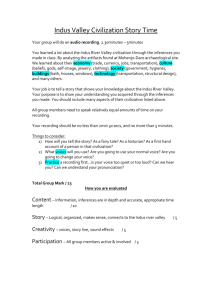
![Indus[1] - ridgeaphistory](http://s3.studylib.net/store/data/006736077_1-c59280ecd30594bac8ab21ec7bce4db4-300x300.png)

